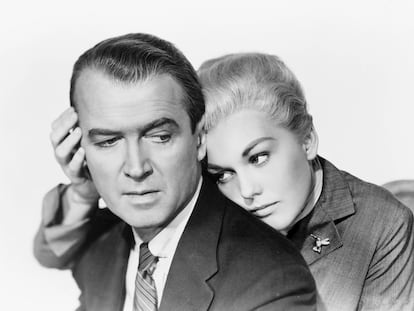Beautiful, but crazy: The dangerous archetype perpetuated by the remake of ‘Fatal Attraction’
The Paramount+ limited series fails to redefine its characters for the sensibilities of the times, and continues to replicate the harmful figure of the bunny boiler, portraying men as the victims of women

Immersed in a culture of comfort that is set on using remakes as a surefire wellspring of risk-free contents, the announcement of a new version of Fatal Attraction in the form of a limited series seemed to promise a different perspective of the controversial original movie, thanks to Alexandra Cunningham’s involvement as director, as well as showrunner and executive producer. Many assumed that, with a woman at the helm, the misogyny of the source material would be toned down. However, to the surprise of many viewers, the updated version replicates the core ideas of Adrian Lyne’s movie: the couple prevails by expelling the third parties as they cling to their traditional family values.
The context in which the original version was released helps to understand the storytelling of the past. As writer Susan Faludi points out in Backlash: The Undeclared War Against American Women, “Hollywood restated and reinforced the backlash thesis: American women were unhappy because they were too free; their liberation had denied them marriage and motherhood.” María Castejón, author of Rebeldes y peligrosas de cine (Rebel and dangerous women in film), points out that Alex, Glenn Close’s character, is an independent woman with no ties, single, who succeeds in her job, and alludes to Faludi, who explains that all these stories must be seen as a reaction to the second wave of feminism. “In the 1980s, they adhered to the dichotomous model of being either the loving superwife who left her career, or a reflection of Close’s character. It’s no surprise that the remake is appearing now, because even though they are not sending us home anymore, we are immersed in a vicious capitalism; if we work in positions where we are not a threat and our salary is somewhat trivial, they can continue making films like this so that the message continues to sink in,” she says.
The bunny boiler
The film gave rise to the term “bunny boiler,” which, Castejón explains, could well be defined as “a fusion between a raving mad woman and a femme fatale.” It comes from the way in which Alex takes revenge on Dan (who does not want to be with her after their torrid affair) by boiling his daughter’s pet rabbit in a pot. Thus, a dangerous archetype was born, one that for many is still valid today: that of the “cute but psycho,” the famous crazy ex-girlfriend that serves as a way to externalize responsibility and justify, normalize and shift the responsibility for harmful behavior onto the victim.
How is it possible, then, that in a moment in which remakes tend to adjust to the sensibilities of the times, the archetype remains intact in this version starred by Joshua Jackson and Lizzy Caplan? “The cause for concern is that fiction maintains many archetypes, and this one, for me, is not more perverse than so many others, like the one about the ugly, intelligent girl who becomes a stunning beauty after she has her braces removed. In Fatal Attraction, women are pathologized, something that happens repeatedly both in film and in television fiction, as is the case with the series Mare of Easttown. Yes, they are interesting characters, but they have to have some underlying trauma, because it seems that the character doesn’t work without traumas and mental health problems,” says Sonia Herrera Sánchez, PhD in audiovisual communication and specialist in cinema and feminist studies.
“The hot-crazy matrix is/was supposed to be a misogynistic joke dreamt up by men on the internet who argued that women were a mixture of hot and crazy. The original YouTube video began by stating that all women were naturally crazy and psycho, and the real challenge for men is in finding a woman who is hot enough to fuck without being so crazy that ‘you end up in prison.’ There’s a specific nod to killing or harming her, because she’s so insufferable.” writes Dr Jessica Taylor in Sexy But Psycho. In fact, many chronicles relate that during the screenings of the original Fatal Attraction, men used to shout at the screen “Kill her off now!” The basic theory, writes Taylor, “is that men want a woman who is hot (and naturally crazy), but not so disordered that you can’t date or marry her.”
The figure of the bunny boiler served to portray men as the victims of women in the 1990s, and it was not even necessary to resort to fiction to build and reinforce this archetype: the case of Monica Lewinsky was a great example. Glenn Close has always expressed her regret for having portrayed such a harmful figure for the cultural imagination. Before shooting the film, she reached out to several psychologists in order to create a truthful character, which she saw as a woman deserving of empathy. However, that was far from being the final result. Michael Douglas refused to play “a weak character,” so with each rewriting of the script Dan became more attractive and relatable, while Alex turned more and more perverse, even repulsive. Let’s not forget that at that time Douglas did not hesitate to claim to be fed up with the feminists and their “unreasonable demands.”
“In the film, Alex’s character has a house in New York, next to a butcher shop, and in the few sequences in which she goes down to her door, a couple of men appear with a cow on their shoulders. The image cannot be more dehumanized! This sends the message that this independent woman who tells Douglas that he has to take responsibility for having had an affair is crazy. It is impossible for anyone to like the character,” says María Castejón.
As Patrick J. Kennedy, one of the leading voices in the field of mental health and addiction, explains in The New York Times, the character of Alex contributed to the stigmatization of mental health. Meanwhile, Close has stated that none of the psychologists she consulted thought that the character had a mental problem; they just assumed that she had probably been abused by a relative when she was a child, which of course, can lead to a mental disorder. Sonia Herrera Sánchez adds that, in fact, this type of mental health problems has not been analyzed in such depth when it comes to portraying male characters, which tend to be linked to a certain alcoholism. “Women’s trauma is not usually related to consumption, but rather to depression, anxiety, and in this case, to the archetype of the crazy woman, which has its own particular characteristics,” she says.
Finally, the figure of the bunny boiler, which is linked to a catchphrase that has become a sales magnet (“cute but psycho”), continues to infiltrate our daily lives – and even our closets, as many brands bet on this message to sell t-shirts. “It is alarming and dangerous, because there is no digital and audiovisual literacy among the new generations, so I don’t know how they might interpret it. It is also strange how this message is also associated with characters whose sexuality is enhanced, because we still have a long way to go regarding sex, even from within feminism,” says Castejón. For her part, Sonia Herrera Sánchez believes that there is always a certain risk when something becomes part of the pop culture, as it tends to be trivialized. “It all depends on how we reappropriate that, politically. If we wear a t-shirt that says ‘cute but psycho’ and it helps us talk about aesthetic pressure – because apparently, if you are beautiful, you must have some defect – or if it helps destigmatize mental health, then it can be an interesting tool. It depends on how we use it,” she points out.
The revival of Fatal Attraction has not only been a failed opportunity to fix the mistakes of the past, but it also reveals an even more worrying reality: if fiction is always a reflection of the moment in which it is produced, then it is no coincidence that now, as misogyny shows its face again, the bunny boiler archetype has so shamelessly returned.
Sign up for our weekly newsletter to get more English-language news coverage from EL PAÍS USA Edition
Tu suscripción se está usando en otro dispositivo
¿Quieres añadir otro usuario a tu suscripción?
Si continúas leyendo en este dispositivo, no se podrá leer en el otro.
FlechaTu suscripción se está usando en otro dispositivo y solo puedes acceder a EL PAÍS desde un dispositivo a la vez.
Si quieres compartir tu cuenta, cambia tu suscripción a la modalidad Premium, así podrás añadir otro usuario. Cada uno accederá con su propia cuenta de email, lo que os permitirá personalizar vuestra experiencia en EL PAÍS.
¿Tienes una suscripción de empresa? Accede aquí para contratar más cuentas.
En el caso de no saber quién está usando tu cuenta, te recomendamos cambiar tu contraseña aquí.
Si decides continuar compartiendo tu cuenta, este mensaje se mostrará en tu dispositivo y en el de la otra persona que está usando tu cuenta de forma indefinida, afectando a tu experiencia de lectura. Puedes consultar aquí los términos y condiciones de la suscripción digital.
More information
Archived In
Últimas noticias
Most viewed
- Oona Chaplin: ‘I told James Cameron that I was living in a treehouse and starting a permaculture project with a friend’
- Reinhard Genzel, Nobel laureate in physics: ‘One-minute videos will never give you the truth’
- Sinaloa Cartel war is taking its toll on Los Chapitos
- Why the price of coffee has skyrocketed: from Brazilian plantations to specialty coffee houses
- Silver prices are going crazy: This is what’s fueling the rally











































